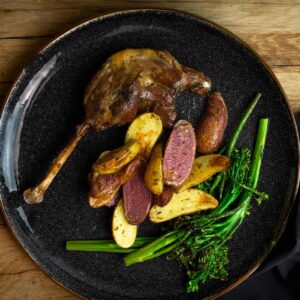
Canada Goose Confit
Take a French approach to get buttery, tender goose legs
Ingredients
- 2-4 Canada goose legs
- Kosher salt
- 28 oz duck fat
- 4-8 tbsp salted butter
- 2 shallots sliced
- 2 tsp garlic freshly minced
- 2 tsp ginger freshly minced
- 5-8 star anise
- 5-8 whole cloves
- 4-6 cinnamon sticks
- 2 tbsp coriander seeds whole
- 2 tbsp black peppercorns whole
- 2 sprigs fresh thyme
- 2 sprigs fresh rosemary
- Orange zest from 2 medium oranges
Instructions
- Lightly salt all sides of the goose legs and leave them in the fridge for 12 to 16 hours. If you use legs from smaller waterfowl, such as mallards, 8 hours of curing in the fridge will suffice.
- After the meat has cured, heat a thin layer of duck fat over medium heat in a skillet large enough to hold the legs. When hot, sear both sides of the legs, then set aside. Add a bit more duck fat, if necessary, followed by sliced shallot. Once shallot is slightly soft and seared, add the garlic and ginger, stir for a few minutes, then turn the heat to medium-low.
- Add at least 14 ounces of duck fat and 4 tablespoons of salted butter to the skillet and allow them to melt.
- Add the star anise, cloves, cinnamon sticks, coriander seeds, peppercorns, thyme, rosemary, and orange zest, and simmer at 200 F for 5-10 minutes to imbue the fat with flavor.
- Add the goose legs and more duck fat. The liquid fat should cover at least half the goose legs, from bottom to top. Simmer on the stovetop, not in the oven, for at least 6 hours and up to 8 hours. Flip the legs every half hour, and ensure the fat covers half the legs at all times. Add more fat if necessary. Ideally, the temperature of the fat should stay around 200 F.
- The legs are done when the meat is tender. Test the meat for tenderness by touching it with your finger. There should be a bit of give, versus feeling like a rock, and the meat should feel ready to fall off the bone.
- Remove when the meat is done. Serve immediately and enjoy with a side of roasted potatoes or steamed vegetables.
Nutrition
Calories: 1157kcalCarbohydrates: 22gProtein: 31gFat: 110gSaturated Fat: 41gPolyunsaturated Fat: 11gMonounsaturated Fat: 51gTrans Fat: 1gCholesterol: 225mgSodium: 308mgPotassium: 921mgFiber: 10gSugar: 2gVitamin A: 1005IUVitamin C: 14mgCalcium: 216mgIron: 8mg
Tried this recipe?Let us know how it was!